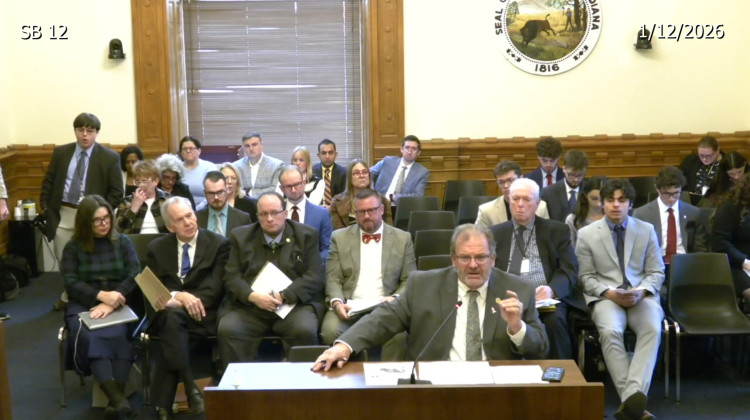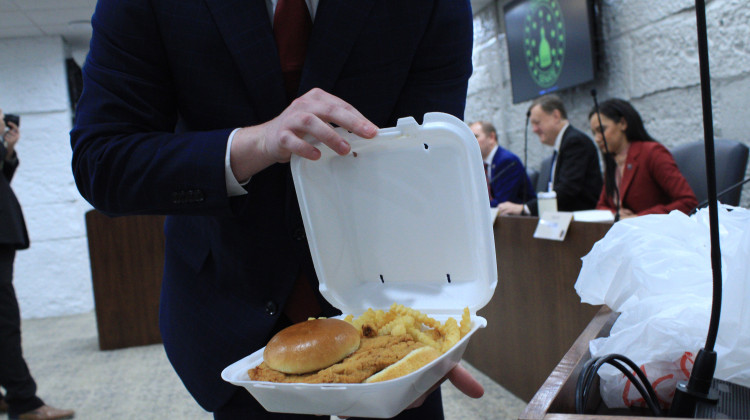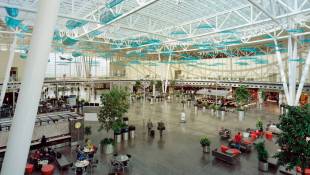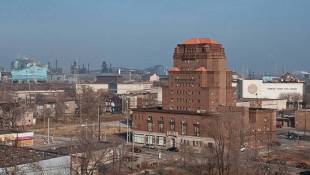
The 84-foot tugboat Arizona, left, waits to help the 656-foot bulk carrier Federal Danube, right, turn around at its berth in the Port of Indiana-Burns Harbor. Photo by: Annie Ropeik/IPB News
Indiana’s ports move millions of tons each year of the stuff that’s made and used at Midwest factories, including steel, grains and coal. The three ports – Burns Harbor on Lake Michigan and Jeffersonville and Mt. Vernon on the Ohio River – connect Indiana to the national and global economies, and each has to find its own ways to keep up with change.
You might picture a port as a lot of water, docks and big container ships tied up. Burns Harbor is not that port, but it’s the closest thing to it in Indiana.
The facility juts out over Lake Michigan in Portage, 35 miles southeast of Chicago, amid steel mills and sand dunes.
A barge floats at one of its concrete docks, flanked by a loader reaching in to scoop out its dusty white contents.
“Magnesite, from China,” says port director Ian Hirt.
Magnesite is a mineral used in all kinds of manufacturing. This barge-load of it is just a tiny bit of the 8 to 10 million tons of cargo Burns Harbor moves every year.
That’s the weight of 36 Sears Towers – fitting, as that Chicago skyscraper is just visible on the horizon.
Hirt says this magnesite started out on a big ship, and made a 25-day journey “across the Pacific, most likely through the Panama Canal, up to New Orleans,” where he says it was loaded onto barges.
“Those came up the Mississippi River, eventually to the Illinois River,” he says. It transited waterways around Chicago, went “out across Lake Michigan, and then into Burns Harbor.”
That leg took three weeks. Now, a truck can take this magnesite from China to a warehouse in Ohio.
All that wending over water is still the cheapest way, per mile, to move this stuff long-distance. A single barge, with its 1,500-ton capacity, can hold 15 times as much as a railcar and 70 times as much as a truck.
“It costs as much to bring a steel coil from Antwerp, Belgium to Burns Harbor by ship,” Hirt says, “as it does to bring a steel coil from South Bend, Indiana to Burns Harbor by truck.”
Steel is a big reason this port exists.
It’s neighbors with the largest steel mills in the country, including ArcelorMittal Burns Harbor, and U.S. Steel’s Gary Works up the road.
Their customers cluster up at the port to save money buying and moving raw steel.
Minnesota-based Ratner Steel is one of those customers. Its Burns Harbor plant manager, Ryan Molstad, says his company can buy steel at the port and truck it over, or barge it in from anywhere.
“It’s all about freight,” Molstad says. “The closer you are to it, the cheaper it is to get it from point A to point B – whether receiving it or shipping it.”
The steel business isn’t always stable. Global competition and technology have shrunk American mills in recent decades.
Molstad says his U.S. suppliers know being at the port gives Ratner more places to get its raw materials, which keeps prices fair.
Another plus for Burns Harbor: access to interstate highways for trucking products out.
“The port is right on the bottom of Lake Michigan, so we can go east. Minnesota, we couldn’t go east, effectively,” Molstad says. “Since we moved here, we gained a lot of business out in Michigan, Ohio, and we keep going.”
Back out on the docks, longshoremen are unloading a big red ship: the bulk carrier Federal Danube. The Marshall Islands-flagged vessel carried steel beams here from Germany.
When it’s done in Burns Harbor, Ian Hirt says the Danube will probably go north on the Great Lakes to pick up grain bound for Europe.
“Basically as soon as the last of that cargo comes off, they’re gonna throw off the lines and they’re gonna hit the marine highway,” Hirt says.
The tugboat Arizona is waiting to turn the huge ship around. Right now, her captain is asleep on the deck.
This pace is typical at Burns Harbor, but soon, officials hope their newest resident stevedoring company, MetroPorts, will bring in more bulk cargoes – anything counted by weight, not by piece, like that magnesite from China.
Steel is still the staple at Burns Harbor and throughout Indiana’s ports system. But in such a volatile industry, it never hurts to diversify.
This story has been updated.
 DONATE
DONATE




 View More Articles
View More Articles




 Support WFYI. We can't do it without you.
Support WFYI. We can't do it without you.